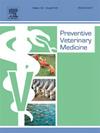Monitoring of Leishmania infantum exposure in the Iberian lynx (Lynx pardinus)
IF 2.2
2区 农林科学
Q1 VETERINARY SCIENCES
引用次数: 0
Abstract
Leishmaniosis, caused by phlebotomine sand fly-borne Leishmania spp., is a multi-host and zoonotic disease in tropical, subtropical and temperate climates, worldwide. Leishmania infantum is the only endemic pathogenic species in Europe, and exposure to this protozoan has previously been reported in a wide range of wild mammals, including felids. However, the information about the exposure of the threatened Iberian lynx (Lynx pardinus) to L. infantum is still very scarce. Consequently, the aims of the present large-scale epidemiological study were: (1) to evaluate the circulation of L. infantum in the free-ranging and captive Iberian lynx populations and (2) to investigate potential risk factors associated with L. infantum exposure during the study period, between 2010 and 2022. A total of 783 Iberian lynxes from captive (n = 296) and free-ranging (n = 487) populations were sampled from different areas of the Iberian Peninsula. Exposure to L. infantum (positive to indirect fluorescent antibody test (IFAT) in serum and/or real-time quantitative PCR (qPCR) in spleen samples) was detected in 80 of the 783 lynxes, so the estimated prevalence (95 % confidence limits) was 10.2 % (8.1–12.3 %). Specifically, anti-Leishmania antibodies were found in 12 of the 469 lynxes (2.6 %; 1.1–4.0 %) and L. infantum kDNA was detected in 68 of the 333 lynxes (20.4 %; 16.1–24.8 %) with a Ct range from 26.0 to 38.0 (median: 36.0). One seroconversion and one seroreversion were observed among the 42 Iberian lynxes longitudinally sampled. Phylogenetic analysis revealed high homology (99.9–100 %) with other L. infantum sequences obtained from wild rabbits (Oryctolagus cuniculus), Iberian hares (Lepus granatensis) and humans from Spain. The multivariate analysis identified the habitat status (free-ranging) and age (adult and subadult) as risk factors potentially associated with L. infantum exposure in Iberian lynxes. Our results indicate moderate and widespread circulation of this pathogen in the Iberian lynx populations, suggesting its potential role as spillover hosts in Iberian Mediterranean ecosystems. Additional studies are warranted to determine the clinical impact of L. infantum exposure in this threatened species.
监测伊比利亚猞猁(Lynx pardinus)接触婴儿利什曼原虫的情况。
利什曼病是由噬血沙蝇传播的利什曼原虫引起的,是一种多宿主和人畜共患的疾病,流行于世界各地的热带、亚热带和温带气候地区。幼年利什曼原虫是欧洲唯一的地方性致病物种,以前曾有报道称包括猫科动物在内的多种野生哺乳动物接触过这种原生动物。然而,有关濒危伊比利亚猞猁(Lynx pardinus)接触婴儿利什曼原虫的信息仍然非常少。因此,本次大规模流行病学研究的目的是(1) 评估伊比利亚猞猁散养和圈养种群中婴儿嗜血杆菌的传播情况;(2) 调查 2010 年至 2022 年研究期间与接触婴儿嗜血杆菌相关的潜在风险因素。研究人员从伊比利亚半岛的不同地区采集了圈养(296 头)和放养(487 头)伊比利亚猞猁种群的 783 个样本。783 只猞猁中有 80 只检测到暴露于幼年利什曼病(血清中间接荧光抗体检测 (IFAT) 呈阳性和/或脾脏样本中实时定量 PCR (qPCR) 呈阳性),因此估计发病率(95 % 置信限)为 10.2 %(8.1-12.3 %)。具体来说,469 只猞猁中有 12 只(2.6 %;1.1-4.0 %)发现了抗利什曼病抗体,333 只猞猁中有 68 只(20.4 %;16.1-24.8 %)检测到了婴儿利什曼病 kDNA,Ct 值范围在 26.0 到 38.0 之间(中位数:36.0)。在纵向采样的 42 只伊比利亚猞猁中,发现了 1 例血清转换和 1 例血清再转换。系统发育分析表明,该病毒与从西班牙野兔(Oryctolagus cuniculus)、伊比利亚野兔(Lepus granatensis)和人类身上获得的其他婴儿病毒序列具有很高的同源性(99.9%-100%)。多变量分析发现,伊比利亚猞猁的栖息地状态(自由放养)和年龄(成年和亚成年)可能是与接触婴儿嗜血杆菌有关的风险因素。我们的研究结果表明,这种病原体在伊比利亚猞猁种群中广泛传播,表明它可能是伊比利亚地中海生态系统中的外溢宿主。还需要进行更多的研究,以确定这种濒危物种接触婴儿疱疹病毒的临床影响。
本文章由计算机程序翻译,如有差异,请以英文原文为准。
求助全文
约1分钟内获得全文
求助全文
来源期刊

Preventive veterinary medicine
农林科学-兽医学
CiteScore
5.60
自引率
7.70%
发文量
184
审稿时长
3 months
期刊介绍:
Preventive Veterinary Medicine is one of the leading international resources for scientific reports on animal health programs and preventive veterinary medicine. The journal follows the guidelines for standardizing and strengthening the reporting of biomedical research which are available from the CONSORT, MOOSE, PRISMA, REFLECT, STARD, and STROBE statements. The journal focuses on:
Epidemiology of health events relevant to domestic and wild animals;
Economic impacts of epidemic and endemic animal and zoonotic diseases;
Latest methods and approaches in veterinary epidemiology;
Disease and infection control or eradication measures;
The "One Health" concept and the relationships between veterinary medicine, human health, animal-production systems, and the environment;
Development of new techniques in surveillance systems and diagnosis;
Evaluation and control of diseases in animal populations.
 求助内容:
求助内容: 应助结果提醒方式:
应助结果提醒方式:


